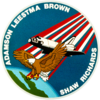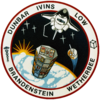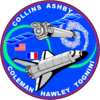Space Shuttle Columbia
The space shuttle Columbia (NASA Designation: OV-102) was the first of NASA's space shuttles to carry out missions outside of Earth. It was launched for the first time on April 12, 1981, and ended its existence when it was destroyed upon re-entry into the atmosphere on February 1, 2003, taking its seven crew members with it.
- First flight:
- 12-14 April 1981 (Tripulation: John W. Young and Robert Crippen).
- Remarkable missions:
- STS 1 to 5 in 1981-1982 was the first flight of Spacelab built by the European Space Agency (ESA).
- STS-50, from 25 June to 9 July 1992, was the first extended duration mission of the Space Shuttle.
- STS-93, July 1999, the X Chandra Ray Observatory is placed in orbit.
- Last anomaly: STS-83 Mission, 4-8 April 1997. The mission was interrupted by the trans-shipper directors because of a problem with the fuel cell N° 2, which showed evidence of internal degradation of post-launch voltage.
Flights
The shuttle Columbia completed 26 successful missions, along with one mission aborted four days after launch (STS-83). Most of its missions were dedicated to scientific research and the launch of communications satellites, including the launch of the Chandra X-ray Observatory.
Had Columbia not been destroyed on STS-107, it would have been fitted with the external airlock/docking adapter to perform STS-118 (an International Space Station assembly mission), originally planned for November 2003. Columbia was scheduled for this mission because Discovery was out of service during its Major Orbital Modification, and because the ISS assembly schedule could not be accomplished with just Endeavor and Atlantis.
Table of missions
| Date | Name | Notes |
|---|---|---|
| 12 April 1981 | STS-1 | First mission of the Space Shuttle. First flight from Columbia. |
| 12 November 1981 | STS-2 | Second test flight. |
| 22 March 1982 | STS-3 | Third test flight. First and only landing at White Sands, New Mexico. |
| 27 June 1982 | STS-4 | Last test flight. |
| 11 November 1982 | STS-5 | First flight. Launch of 2 communications satellites. |
| 28 November 1983 | STS-9 | Spacelab's first mission. |
| 12 January 1986 | STS-61-C | Launch of communications satellites. Last successful space shuttle mission, before the Challenger shuttle crash. |
| 8 August 1989 | STS-28 | SDS satellite launch (Satellite Data System). |
| 9 January 1990 | STS-32 | SYNCOM IV-F5 satellite launch. |
| 2 December 1990 | STS-35 | Use of the ASTRO-1 observatory. |
| 5 June 1991 | STS-40 | Spacelab Mission. |
| 25 June 1992 | STS-50 | Spacelab Mission. |
| 22 October 1992 | STS-52 | LAGES II, experiments in microgravity. |
| 26 April 1993 | STS-55 | Spacelab Mission. |
| 18 October 1993 | STS-58 | Spacelab Mission. |
| 4 March 1994 | STS-62 | Experiments in microgravity. |
| 8 July 1994 | STS-65 | Spacelab Mission. |
| 20 October 1995 | STS-73 | Spacelab Mission. |
| 22 February 1996 | STS-75 | Satellite connected to another cable, TSS (Tethered Satellite System). |
| 20 June 1996 | STS-78 | Spacelab Mission. |
| 19 November 1996 | STS-80 | Escudo de Estela (Wake Shield Facility, WSF); ASTRO-SPAS. |
| 4 April 1997 | STS-83 | Mission truncated due to a problem in fuel cells. |
| 1 July 1997 | STS-94 | Spacelab Mission. |
| 19 November 1997 | STS-87 | Experiments in microgravity. |
| 17 April 1998 | STS-90 | Spacelab Mission. |
| 23 July 1999 | STS-93 | Launch of the X Chandra Ray Observatory. |
| 1 March 2002 | STS-109 | Delivery of services to Hubble Space Telescope. Columbia's last successful mission. |
Tribute and Mission Badges
| NASA Tribute by Space Shuttle Columbia | |||||||
|---|---|---|---|---|---|---|---|
| Mission badge for Columbia mission flights | |||||||
STS-1 | STS-2 | STS-3 | STS-4 | STS-5 | STS-9 | STS-61-C | STS-61-E* |
STS-28 | STS-32 | STS-35 | STS-40 | STS-50 | STS-52 | STS-55 | STS-58 |
STS-62 | STS-65 | STS-73 | STS-75 | STS-78 | STS-80 | STS-83 | STS-94 |
STS-87 | STS-90 | STS-93 | STS-109 | STS-107 | STS-118** | ||
* Mission canceled after the Challenger shuttle accident.
** Mission carried out by Endeavour, after the loss of Columbia on STS-107.
Last Mission
Columbia's last mission was designated STS-107, and took place between January 16 and February 1, 2003.
At the time of takeoff, the orbiter received an impact in the lower part of the left wing, caused by the detachment of a piece of polyurethane foam, insulating the external tank.
Impact occurred 81-82 seconds after launch. According to NASA studies, the fragment had a size of 30,000 cm³ (i.e. the size of a 30 L tank), and a weight of approximately 1 kg, and could have struck the wing at about 805 km /h; the force of the impact was calculated at almost a ton. The tangential blow punctured a couple of panels behind the leading edge, near the landing gear well. The accident was not noticed by the crew nor during the mission. Mission Control was apparently aware of the detachment of the chunk, but dismissed the scope of the event.
The problem materialized during re-entry into Earth's atmosphere.
Due to the impact of this fragment, thermal protection tiles detached near the landing gear; In this way, the abrasive heat of the plasma that is formed during atmospheric reentry entered, causing the destruction by fusion of the internal structure of the left wing, large enough to cause destabilization and detachment.
During re-entry, thermal sensors detected an unusual rise in temperature in the region of impact. And due to the heat, the wing finally detached, causing the shuttle to spin violently on itself, falling apart structurally.
At 07:59:32 CT, communication with the Columbia was lost; A few minutes later, the world news began to broadcast images of the shuttle disintegrating in the air, which reported the loss of the shuttle (valued at about 2000 million euros, year 2003), and the death of its seven astronauts.
After that moment, the space missions were canceled to review what were the failures of the same shuttle and the others. After two years of reviewing and supervising the shuttles, their activity resumed with the launch of the space shuttle Discovery.
Contenido relacionado
Project Monkey
Submarine cable
Secure Shell































